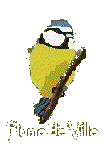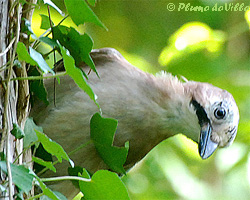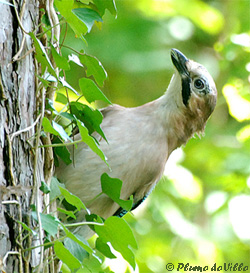Plume de Ville
From day to day.
°°°°°°°°°°°°°°°°°°°°°°° °
November 2008
2 November
I see it in
our balcony two or three times a year, but I never managed to take
pictures.
Very shy, it always flied away at the sight of the slightest movement
behind
the window, and as it perches rather quite high in the trees I must
approach
the windowpane.
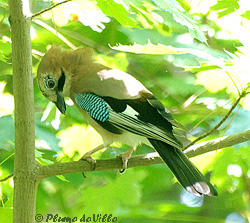
Eurasian jay.
[Garrulus glandarius Passeriformes Corvidae -]
This one (at the Parc de
Sceaux), accepted us long enough to give us its portrait.
Cooee! Of
course, I know you're there!
Busy to visit a tree trunk, it carefully inspects the bark; it turns
around,
disappears for a moment but still takes a quick look at regular
intervals from
behind the screen.
In search of a delicacy or checking one of its caches? Then he will
roost on a sunny
branch where it will stay for one or two minutes.
A
delicate
pink beige, its wings a beautifully turquoise blue gingham, emphasized
by a
white spot he likes deciduous forests, oak of course and their acorns
that it
picks and hide in autumn.
It can carry a small number in a pocket under its beak, before eating
them or hide
them in a cleft of a tree or bury them under the leaves and moss. He
visits its
caches and regains some of its treasures. Probably, so I think it
visits also the
coffers of some congeners ... and squirrels around the corner (and vice
versa?).
Many acorns will be forgotten and germinate, renewing its beloved oaks.
Chestnuts, hazelnuts, beechnuts, fruits and berries are also on the menu. As
for insects they hunted
during the feeding of chicks.
[Ph. 101008 ]
3 November
A
"kyakkkyakkkyakk" which screechs, is heard above the trees of the Parc
de
Sceaux, taken over by several individuals. The appeal is hard, shrill,
and not
really melodic. One of those cries that imagination locate rather in
tropical
forests!... or at home... by
my budgerigars
The sound cracks rather than "sings". This all green touch of exoticism is the Rose-ringed Parakeet. [Psittacula Krameri - Psittaciformes Psittacidés -]. Great parakeet of forty centimeters.
It comes
from tropical Africa and Asia.
Remarkable for their beautiful plumage ... and their powerful song,
they live
in colonies, for several years around Paris, north and south.
Fontenay-aux-Roses, Bourg-la-Reine, Chatenay-Malabry, the Hay les Roses
... among
others towns, near Paris (south side).
And in Paris itself , where they also nest now.
Only the male has a black collar and pink in the neck, neatly draw
around the
neck.

A colony has
established at the Parc de Sceaux where it nests. They nest in tree
holes, old
nests of peaks for example. Like this one, in April 2008.
Their long tail makes them recognizable in flight. And if that is not
enough,
the entire group squawks in flight.
Rose-ringed
Parakeet, also known as the Ringnecked Parakeet is a common name given
to
several Psittacula:
Psittacula
eupatria (Red-breasted Parakeet).
Psittacula krameri krameri (African-ringnecked Parakeet).
Psittacula krameri
manillensis (Indian-ringnecked Parakeet), the biggest one.
In psittaculture,
they are coloured pastel, yellow, green (as here, "natural" colour)
or blue.
4 November
As its English name says: Juniper Shield Bug, likes the junipers and larvae that feed on its berries.
Species of northern Europe, 8-10 mm. Active all year. In the wasteland but also in wet places.
I did not find its common name in French.
Found sunbathing on the windowpane.
http://www.britishbugs.org.uk/heteroptera/Acanthosomatidae/cyphostethus_tristriatus.html
http://aramel.free.fr/INSECTES10bisbis'-01.shtml
11 November
Yesterday, grey,
rainy, windy... Night of storm. This morning, calm returned.
Pointillism king...
Blackish
brown,
seen from afar; more closely, it appears all nicely speckled
of small white spots on
its belly and
orange on the back. These spots are more numerous and larger in the
autumn and
its beak blackened.
This is not a loner! His delight is to be in the crowd. His exuberance
is heard
from afar; the chatty give their entire repertoire, often a strange
mixture of
screams, songs and many imitations, even metallic.
They are very numerous at this time. Compact Groups fly from a terrace
to
another one. Usually they come together late in the day, but yesterday
(due to
the arrival of a depression?) big flocks passed continuously throughout
all the
day.
European Starling - Sturnus vulgaris -
It
puzzled
me. He spent long-time alone on the terrace.
It regurgitated in its beak round seeds, probably berries, chew them a
little and
then tipping up the head, it gulps then again.
Has it made his reserve of vine berries, where I saw a whole flock the
other
day, hanging and picking, and is now savouring quietly, away from
friends, what
it had harvested?
13 November
Beautiful
this tit with its very thin black ventral band that starts at the chin
and makes
a gentle curve.
Pity beautiful tit, but our small territory cannot accommodate two
houses! And
I deeply regret it. Cohabitation would be very difficult. For this nest
box you
must have a size of blue tit.
25 November
Not favourable for pictures the lasts days, grey and snowy.
Today, it is still grey, it is cold (0 ° this morning). A wind
carries the last
leaves. Already a tint of winter.
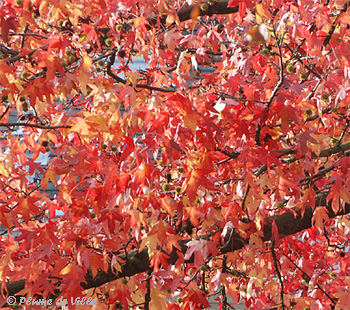
So to warm up a bit, at least the eyes, some joyful colors of the week
before.

You
never
get tired of maples.
Over an impressionist
background, a flight of Canada geese led by a bar-headed goose.
The
bar-headed
goose. (Anser indicus - Anseriformes Anatidae-)
In the wild they live in central Asia and winters in northern India.
During the
migration it breaks altitude records crossing the Himalayan Mountains.
It is present in Paris. But introduced, of course, as his flight
companion the
Canada Goose, as this elegant little goose (2kg, 70cm) is breed as
ornamental
bird.
[mi-November Min]
27 November
Plump...
[Aegithalos caudatus - Passeriformes Aegithalidae -]
I
like its pompom appearance.
A small band of six chickadees in an alder. They never stay at rest
while
exploring the tree, visiting the branches, catkins, fruits.
Hard to photograph them, take patience and wait for a rare short moment
of
calm.
Long
tapered tail, black and white, as long as the small body.
It
is called "tit" but it doesn't belong to the same family and builds
a nest instead of nesting in a cavity.
Very small (a dozen cm and 7g), it feeds primarily on insects.
Beautiful pictures of a Long-tailed tit nest:
http://www.beneluxnaturephoto.net/forumf/index.php/topic,11536.0.html
The
tree of
"long-tailed": a Black Alder, Common Alder. [Alnus glutinosa - Betulaceae
-]
Male
and female catkins. Female catkins are purple in winter and greenish
when
they bloom. They are superficially similar to conifer cones.
The fruits remain on the tree all the year even when their seeds (achenes, winged seeds) fell. They contain tannin and are used by aquarist to darken and acidify the water. His bark was used to make beautiful black dyes (used in particularly for felt hats).
Its leaf is truncated or notched at the top, slightly heart-shaped. The
white
alder [Alnus incana], has pointed leafs and similar
fruits.
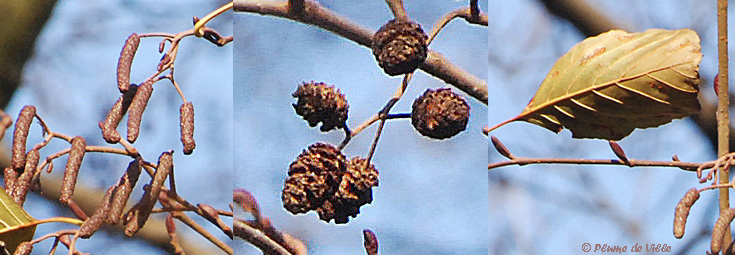
[mi-November Min]
